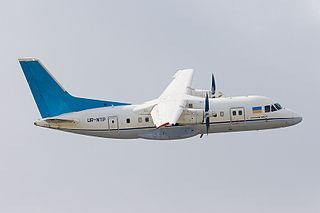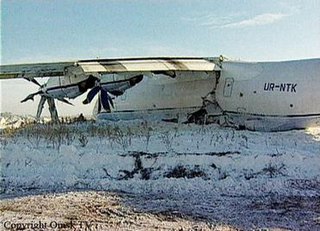
The Antonov An-140 is a turboprop regional airliner, designed by the Ukrainian Antonov ASTC bureau as a successor to the Antonov An-24, with extended cargo capacity and the ability to use unprepared airstrips.

Mehrabad Airport, is an airport serving Tehran, the capital city of Iran. Prior to the construction of the larger Imam Khomeini International Airport in 2007, Mehrabad was Tehran's primary airport in both international and domestic traffic, but now serves only domestic flights. Despite this, in 2016, Mehrabad Airport was the busiest airport in Iran in terms of passengers, handling 16,678,351 passengers in total. The airport is also used by the Government of Iran and is one of the bases of the Iranian Air Force.

American Airlines Flight 157, a Douglas DC-6, departed on November 29, 1949, from New York City bound for Mexico City with 46 passengers and crew. After one engine failed in mid-flight, a series of critical mistakes by the flight crew caused the pilot to lose control of the plane during the final approach to a routine stopover at Love Field in Dallas, Texas. The airliner slid off the runway and struck a parked airplane, a hangar, and a flight school before crashing into a business across from the airport. 26 passengers and two flight attendants died. The pilot, co-pilot, flight engineer, and 15 passengers survived.

Pakistan International Airlines Flight 688 was a domestic passenger flight from Multan to Islamabad with a stopover in Lahore, operated by Pakistan's flag carrier Pakistan International Airlines. On 10 July 2006, the aircraft operating the route, a Fokker F27, crashed into a mango garden after one of its two engines failed shortly after takeoff from Multan International Airport. All 41 passengers and four crewmembers on board were killed.

Iran Air Flight 291 was a flight from Mashad Airport to Tehran-Mehrabad Airport that crashed on 21 January 1980 during its approach to Tehran-Mehrabad runway 29 in foggy and snowy weather conditions, killing all 128 people on board. At the time, Iran Air Flight 291 was the deadliest aircraft disaster in Iranian history.

On 5 November 2010, JS Air Flight 201, a Beechcraft 1900 passenger aircraft on a charter service from Karachi to the Bhit Shah gas field in Sindh, Pakistan, crashed near Karachi's Jinnah International Airport, after suffering an engine malfunction at take-off. All 21 people on board were killed.

Iran Air Flight 277 was a scheduled Iran Air flight from Mehrabad International Airport, Tehran to Urmia Airport, Iran. On January 9, 2011, the Boeing 727 serving the flight crashed after an aborted approach to Urmia Airport in poor weather. Of the 105 people on board, 78 were killed. The official investigation concluded that icing conditions and incorrect engine management by the crew led to a double engine flame-out, loss of altitude and impact with the ground.

On 8 February 1993, Iran Air Tours Flight 962, a Tupolev Tu-154, collided in mid-air with an Islamic Republic of Iran Air Force (IRIAF) Sukhoi Su-24 attack aircraft near the Iranian capital of Tehran, killing all 133 people aboard both aircraft. It is the deadliest aviation accident in 1993.

Aeroflot Flight 25 was a scheduled domestic passenger flight that crashed on 4 April 1963 in the region of Rybnaya Sloboda, Tatar ASSR, Russian SFSR while en route from Moscow-Sheremetyevo to Krasnoyarsk Airport, Russian SFSR. All 67 people aboard were killed in the accident.
Sepahan Airlines was an airline based in Isfahan, Iran.

On 27 January 2001, an Antonov An-70 prototype crashed close to Omsk Tsentralny Airport, Russia during testing of the aircraft. All 33 passengers and crew on board the aircraft survived.

On 18 May 2016, a Silk Way Airlines Antonov An-12 cargo plane crashed after an engine failure shortly after taking off from Dwyer Airport in southern Afghanistan, en route to Mary International Airport in Turkmenistan. Seven of the nine crew members on board were killed in the crash, which was the second incident for Silk Way in Afghanistan after a 2011 Il-76 crash. Two others were taken to hospital and treated for their injuries.

Centurion Air Cargo Flight 164 was a chartered international cargo flight, flying from Bogota's El Dorado International Airport while en route to Miami International Airport. The flight was operated by Kalitta Air and the aircraft was wet leased by Centurion Air Cargo. On 7 July 2008, the aircraft, a Boeing 747-209BSF registered as N714CK, crashed shortly after takeoff. All aboard suffered injuries, but none were killed. Two people on the ground were killed after the plane slammed into a farm. The crash was the second crash of a Boeing 747 in 2008 in Kalitta Air service, after a previous accident at Brussels in May.

Tropical Airways Flight 1301 (TBG1301/M71301) was a domestic short-haul passenger flight, flying from Cap-Haïtien International Airport in Cap-Haïtien, Haiti to the commune of Port-de-Paix which crashed onto a sugarcane field less than 10 minutes after take off on the evening of 24 August 2003. The aircraft was a 19-seater Let L-410 Turbolet carrying 19 passengers and 2 crew. Witnesses stated that the aircraft caught fire during take-off and exploded when it hit the ground. All on board were killed.

The 2001 Faraz Qeshm Airlines Yak-40 crash occurred on 17 May 2001 when a short-haul trijet Yakovlev Yak-40 being operated by Faraz Qeshm Airlines crashed while en route to Gorgan Airport from Tehran-Mehrabad Airport in Iran. The aircraft crashed in mountainous terrain while flying in poor weather conditions about twenty kilometers south of Sari killing all thirty people on board. Passengers aboard the aircraft included Rahman Dadman, Iran's Minister of Roads and Transportation, and six members of parliament.

Iran Aseman Airlines Flight 3704 was a scheduled Iranian domestic passenger flight from Iranian capital Tehran Mehrabad International Airport to Yasuj in southwest Iran. On 18 February 2018, during its approach to Yasuj, the aircraft serving the flight, an ATR 72-212 operated by Iran Aseman Airlines, crashed into Mount Dena in the Zagros Mountains near Noqol village in Semirom county, Isfahan Province. All 66 people on board, including 60 passengers and 6 crew members, were killed.

Siberian Light Aviation Flight 42 was a domestic Russian scheduled passenger flight from Kedrovy to Tomsk, both in Tomsk Oblast in Siberia. On 16 July 2021, the Antonov An-28 operating the flight suffered icing in the engines leading to a dual engine failure 10 minutes into the flight and crash landed in a remote area in the Vasyugan Swamp in the Bakcharsky District. The pilot suffered a broken leg requiring surgery, but all of the remaining passengers and crew escaped with only minor injuries. An investigation ultimately concluded that the pilots of the aircraft had not activated the anti-icing system, which led to an accumulation of ice, resulting in engine failure. Initially praised as a hero for his handling of the incident, the pilot of the flight was ultimately criminally charged for violating safety protocols, leading to the crash.

The 1994 South Pacific Airmotive DC-3 crash took place on 24 April 1994, when a Douglas DC-3 airliner operated by South Pacific Airmotive, tail number VH-EDC, ditched into Botany Bay shortly after takeoff from Sydney Airport in Sydney, New South Wales, Australia. The cause of the crash was determined by the Bureau of Air Safety Investigation to have been a power loss in the aircraft's left engine caused by an inlet valve being stuck in the open position, compounded by inadequate action on the part of the pilots; Rod Lovell, the pilot in command of the flight, has disputed BASI's conclusions.

















